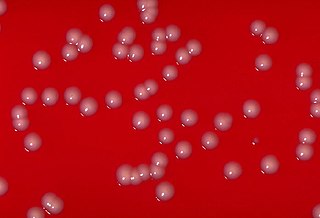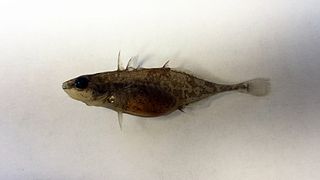
Arthrobacter is a genus of bacteria that is commonly found in soil. All species in this genus are Gram-positive obligate aerobes that are rods during exponential growth and cocci in their stationary phase. Arthrobacter have a distinctive method of cell division called "snapping division" or reversion in which the outer bacterial cell wall ruptures at a joint.

A spirochaete or spirochete is a member of the phylum Spirochaetota, which contains distinctive diderm (double-membrane) gram-negative bacteria, most of which have long, helically coiled cells. Spirochaetes are chemoheterotrophic in nature, with lengths between 3 and 500 μm and diameters around 0.09 to at least 3 μm.

Corynebacterium is a genus of Gram-positive bacteria and most are aerobic. They are bacilli (rod-shaped), and in some phases of life they are, more specifically, club-shaped, which inspired the genus name.

The Rhodobacteraceae are a family of Pseudomonadota in the order Rhodobacterales within the alpha subgroup. Like all Pseudomonadota, they are gram-negative. It contains chemoorganotrophs and photoheterotrophs bacteria. Many occur in aquatic habitats.

The Most Esteemed Order of the Defender of the Realm is a Malaysian federal award presented for meritorious service to the country. The Order Motto are 'Dipeliharakan Allah-Pangkuan Negara'.

Microbacteriaceae is a family of bacteria of the order Actinomycetales. They are Gram-positive soil organisms.
The following is a list of players, both past and current, who appeared in at least one game for the New York Yankees franchise, including the 1901–02 Baltimore Orioles, and the 1903–12 New York Highlanders.

Brevibacterium linens is a gram-positive, rod-shaped bacterium. It is the type species of the family Brevibacteriaceae.

Membrane-associated transporter protein (MATP), also known as solute carrier family 45 member 2 (SLC45A2) or melanoma antigen AIM1, is a protein that in humans is encoded by the SLC45A2 gene.

RhoD is a small signaling G protein, and is a member of the Rac subfamily of the family Rho family of GTPases. It is encoded by the gene RHOD.

Interferon-induced transmembrane protein 1 is a protein that in humans is encoded by the IFITM1 gene. IFITM1 has also recently been designated CD225. This protein has several additional names: fragilis, IFI17 [interferon-induced protein 17], 9-27 [Interferon-inducible protein 9-27] and Leu13.
The Most Esteemed Order of Loyalty to the Crown of Malaysia is a Malaysian federal award presented for meritorious service to the country and awarded by the sovereign.

A tunneling nanotube(TNT) or membrane nanotube is a term that has been applied to protrusions that extend from the plasma membrane which enable different animal cells to touch over long distances, sometimes over 100 μm between T cells. Two types of structures have been called nanotubes. The first type are less than 0.7 micrometers in diameter, contain actin and carry portions of plasma membrane between cells in both directions. The second type are larger (>0.7 μm), contain both actin and microtubules, and can carry components of the cytoplasm such as vesicles and organelles between cells, including whole mitochondria. The diameter of TNTs ranges from 50 to 200 nm and they can reach lengths of several cell diameters. These structures may be involved in cell-to-cell communication, transfer of nucleic acids such as mRNA and miRNA between cells in culture or in a tissue, and the spread of pathogens or toxins such as HIV and prions. TNTs have observed lifetimes ranging from a few minutes up to several hours, and several proteins have been implicated in their formation or inhibition.

Polyethylenimine (PEI) or polyaziridine is a polymer with repeating units composed of the amine group and two carbon aliphatic CH2CH2 spacers. Linear polyethyleneimines contain all secondary amines, in contrast to branched PEIs which contain primary, secondary and tertiary amino groups. Totally branched, dendrimeric forms were also reported. PEI is produced on an industrial scale and finds many applications usually derived from its polycationic character.

Microbacterium is a genus of bacteria in the family Microbacteriaceae. Microbacteria are common contaminants of laboratory reagents, which can lead to their being misrepresented in microbiome data.
Cellulomonas is a genus of Gram-positive rod-shaped bacteria. One of their main distinguishing features is their ability to degrade cellulose, using enzymes such as endoglucanase and exoglucanase. They are members of the Actinomycetota.

Apeltes is a monospecific genus old ray-finned fish belonging to the family Gasterosteidae, the sticklebacks. The only species in the genus is Apeltes quadracus, the fourspine stickleback or bloody stickleback, which lives in freshwater, brackish and benthopelagic environments of the northwestern Atlantic Ocean between Newfoundland and South Carolina.
Nocardioides is a Gram-positive, mesophilic and aerobic bacterial genus from the family of Nocardioidaceae.












